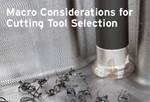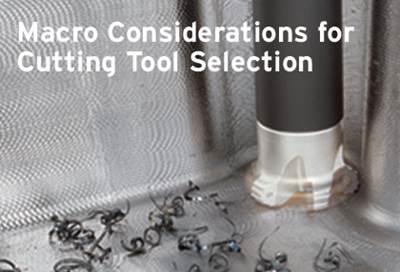Creating a Balanced Cut
Decrease machine downtime and increase productivity with the right gundrilling tool.
The need for high-quality deep holes has long existed, and as part design complexity grows, so too does this need for accurate holes. It is this need from which gundrills were born, and today they are used in almost every industry. Gundrills have been and will continue to be the essential tool for deep-hole drilling applications.
Gundrilling Options
Conventional gundrills are either brazed or solid carbide. They have one effective flute, which creates unbalanced cutting forces that push the drill away from the cutting action. To overcome this unbalance, the gundrill is equipped with built-in guide pads that help create an accurate hole and achieve the desired surface finish. The cutting action pushes the tool and its guide pads against the opposite side of the hole.
A downside to having one effective flute and the use of guide pads is fairly low feed rates. The additional material contact increases friction, which in turn increases heat, limiting productivity.
Two-Effective-Flute Gundrill
An alternative is the two-effective-flute gundrill (aka lipped gundrill), which features two flutes placed 180 degrees apart. This enables the cutting forces to be balanced, keeping the drill tracking straight and helping increase the feed rate.
Gundrill feed rates are calculated in inches per revolution (ipr), similar to other cutting tools. With two effective flutes, the feed rate will be twice as fast as with one flute. Also, since the resulting cut is balanced and there is no guide pad to increase friction, the feed rate per tooth and the rotation cutting speed can be increased. This yields a four to five times greater inches-per-minute feed rate than can be achieved with a conventional gundrill, as well as equal hole straightness and tolerance.
One disadvantage of two-effective-flute gundrills is increased chip evacuation in long-chipping materials such as stainless steels and some high-temperature alloys, because these tools produce chips off of two flutes at a faster rate. The slower feed rate and one large gullet of a single-effective-flute gundrill enable better chip evacuation but decrease productivity.
Indexable Gundrill
Another technology to consider is an indexable gundrill, of which there are two main types. The first type is similar in design to conventional single-effective-flute gundrills and features one screw-down insert with one or more cutting edges and brazed-in or replaceable guide pads. The second type, which is essentially a two-effective-flute gundrill, features a replaceable-head design that uses the frictional forces of the pocket design to hold the insert.
When used on traditional CNC equipment or on dedicated gundrill machines, indexable gundrills offer a big advantage in decreased machine downtime when replacement is necessary. Replacing a conventional gundrill on a CNC machine requires removing the entire tool assembly and gundrill, then replacing the gundrill or taking it to a separate machine for regrinding before the tool can be reinstalled in the machine and the machining process can continue. The process is the same on a gundrill machine, except there are more components to remove (such as guide bushings and support guides) before the tool can be replaced, which is time-consuming.
With an indexable gundrill, screw-down inserts can be changed in minutes and the replaceable head can be changed in seconds, reducing machine downtime.
Some indexable gundrills hold a variety of cutting edge geometries and heads with diameters that range to 0.1 mm. Others offer as many as 10 different diameters and five different cutting edge geometries, so users can have as many as 50 different drill head combinations in one tool and change among them in seconds.
Summary
Today, virtually all industries are seeing an increase in demand for deeper, high-quality holes, and there are many new technologies for making these holes. Now is the time to take a second look at gundrill applications to discover new possibilities for improvement. Use these guidelines to determine whether a two-effective-flute gundrill or an indexable gundrill is the right tool for your deep drilling applications.
Related Content
Treatment and Disposal of Used Metalworking Fluids
With greater emphasis on fluid longevity and fluid recycling, it is important to remember that water-based metalworking fluids are “consumable” and have a finite life.
Read MoreMoldmakers Deserve a Total Production Solution
Stability, spindle speed and software are essential consideration for your moldmaking machine tool.
Read MoreFundamentals of Designing the Optimal Cooling System
The right mold components can help improve mold cooling and thereby produce higher-quality parts.
Read MoreConsiderations for Mold Base Material Selection
Choosing the right material can greatly affect the profitability and cost of your application.
Read MoreRead Next
Macro Considerations for Cutting Tool Selection
Selecting the best cutting tool is a critical activity to your business success. It’s a re-occurring job that directly impacts cycle time and your shop’s competitiveness.
Read MoreHow to Use Strategic Planning Tools, Data to Manage the Human Side of Business
Q&A with Marion Wells, MMT EAB member and founder of Human Asset Management.
Read MoreHow to Use Continuing Education to Remain Competitive in Moldmaking
Continued training helps moldmakers make tooling decisions and properly use the latest cutting tool to efficiently machine high-quality molds.
Read More
















.jpg;maxWidth=300;quality=90)








